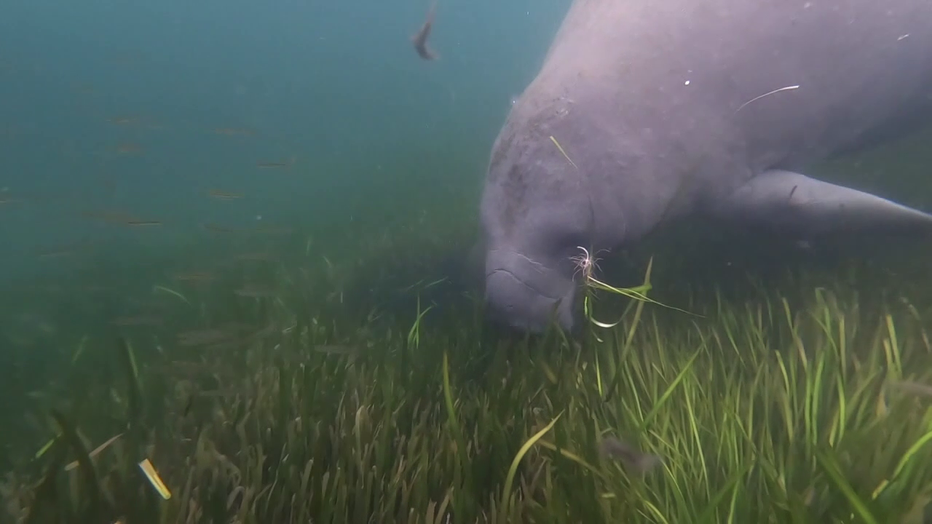MOTE Marine Laboratory heads up seagrass initiative as other scientists call for water quality improvements

Seagrass restoration project
Seagrass plays a vital part in not only protecting Florida shorelines from erosion, but it also helps the underwater ecosystem thrive.?Kimberly Kuizon reports.
SARASOTA, Fla. - Seagrass plays a vital part in not only protecting Florida shorelines from erosion, but it also helps the underwater ecosystem thrive.
In recent years, there has been a loss of seagrass across the state.
The backstory:
Mote Marine Laboratory in Sarasota is trying to figure out how to stop this from happening.
Seagrass is a breeding ground and protector for game fish.
It’s also a source of food for manatees and can help improve water quality.
In areas across the state of Florida, seagrasses are disappearing.
OTHER NEWS: Shark bite survivor's family, TGH doctors discuss 9-year-old's recovery: 'She's done a fantastic job'
"We’ve seen stressors all across the state of Florida impacting our seagrass beds, which are so vital for our water quality, nursery grounds," said Kevin Claridge.
Kevin Claridge is Mote Marine Laboratory’s Vice President of Sponsored Research and Coastal Policy Program.
He said Mote Marine Laboratory is working with the Florida Department of Environmental Protection and the University of Florida in creating a 10-year Florida seagrass restoration plan.
Big picture view:
"Specifically, the funding is looking at what those stressors are on those seagrass systems. Say it’s nutrient change or acidification or less light or nutrient impacts," said Claridge.
The Florida Legislature has approved $2 million dollars in funding to be awarded every year for 5 years for the Seagrass Restoration Technology Development Initiative.
The hope is to find the most tolerant seagrasses that Mote Marine Laboratory and partners can grow for future restoration projects.
"It’s the first time ever really on an international scale. We are working with partners all over the world and what they are doing in planting technologies to understand that genetic makeup better, to help us understand which ones are growing faster," said Claridge.
Sarasota Bay has seen big gains.

In 2024, they witnessed a 19% increase in seagrass coverage.
Dr. David Tomasko, the Director of the Sarasota Bay Estuary Program, said it happened after local governments worked on removing nutrients from the water.
"None of that 2,000 acres came about by transplanting. It came about because the water quality improved because we spent $300 million improving water quality," he said.
Tomako said while the science of growing seagrass is vital, additional funds allocated to wastewater upgrades and storm water retrofits should be considered.
"We want both these things to happen. We want the science to move forward, but we also don’t want elected officials in Tallahassee or Washington D.C. to take their eye off the ball, which is we can recover eco-system scale, but it will cost more than 10-20 million dollars," he said.
He said without change, sea grass will continue to pay the price as Florida grows.
"If you’re not willing to, at the same time, devote enough resources for these big projects. Wastewater upgrades, storm water retrofits it doesn’t understand how well you understand the seagrasses. They won’t grow if the water quality is not good," said Tomasko.
What's next:
Mote Marine Laboratory has completed a green house which will help them experiment on real world stressors to sea grass.
They hope to identify seagrass types which are most resilient to outside changes.
Scientists are also looking at genetic and genomic approaches to generate genetically resilient seagrass which could be natural reproduced in land-based nurseries.
The Source: Information was gathered by FOX 13’s Kimberly Kuizon from Mote Marine Laboratory and the Sarasota Bay Estuary Program.
The Source: FOX 13's Kimberly Kuizon gathered the information for this story.
STAY CONNECTED WITH FOX 13 TAMPA:
- Download the FOX Local app for your smart TV
- Download FOX Local mobile app: Apple | Android
- Download the FOX 13 News app for breaking news alerts, latest headlines
- Download the SkyTower Radar app
- Sign up for FOX 13’s daily newsletter
- Follow FOX 13 on YouTube

